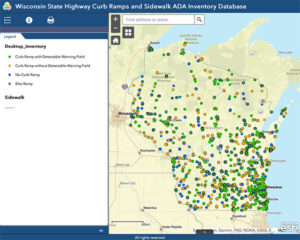Research shows that the truncated dome is the most effective system for providing a distinctive pattern detectable by cane and underfoot.
The Americans with Disabilities Act (ADA), passed in 1990, required the establishment of design criteria for building and altering commercial and public facilities, including sidewalks and curb ramps. In 1991, the U.S. Department of Transportation (USDOT) and the U.S. Department of Justice (USDOJ) developed a set of regulations for new construction and alterations. The regulations include standards that reference the ADA Accessibility Guidelines for Buildings and Facilities (ADAAG), developed by the U.S. Access Board-an independent Federal agency devoted to accessibility for people with disabilities. The guidelines require the installation of detectable warnings on sidewalks, street crossings and curb ramps, hazardous vehicular ways, and transit platform edges.
The guidelines define a detectable warning as “a standardized surface feature built in or applied to walking surfaces or other elements to warn visually impaired people of hazards on a circulation path.” Detectable warnings are texturally unique and standardized features, intended to function much like stop signs. The warning alerts visually impaired pedestrians to the presence of hazards in the line of travel, indicating that they should stop and determine the nature of the hazard before proceeding further.
Since 1991, truncated domes have been the standard design requirement for detectable warnings on curb ramps and at flush transitions from sidewalks to street crossings. The U.S. Access Board temporarily suspended the standard in 1994 but allowed the suspension to expire in 2001, reestablishing the mandate.
The small, flattened domes provide a surface that is distinguishable underfoot and by cane, and they are closely spaced so that pedestrians can maintain stability. In addition, the color of the domes contrasts with the surrounding pedestrian ramp to provide a cue for low-vision persons that a transition from the pedestrian area to the vehicular area is forthcoming.
 Wisconsin State Highway Curb Ramps and Sidewalk ADA Inventory Database
Wisconsin State Highway Curb Ramps and Sidewalk ADA Inventory Database
This application provides a tool for users to view the currently identified inventory of curb ramps, sidewalks and shared use paths along the State Trunk Network (STN) including connecting highways in Wisconsin. This inventory is not complete and consists of locations identified as part of a desktop inventory using aerial imagery as well as curb ramp locations that have been field located and checked.
The Curb Ramp Desktop Inventory contains data on curb ramps locations, sidewalks and shared use paths along the State Trunk Network (STN) including connecting highways in Wisconsin. The desktop inventory was developed in 2014/2015 using WisDOT Photo Log and Google Earth satellite images. It is recognized that there are gaps and limitations in the data, for example interstate interchange curb ramp locations may not be identified where they intersect local roadways. A desktop inventory data validation effort determined that the initial Desktop Inventory may have been missing about 8% of the existing curb ramp locations.
Should you or a family member be in an accident which injuries are sustained, the first thing you should do is contact a personal injury attorney. When you are represented by a skilled attorney, you’ll have your best chance of being fairly compensated for any injuries that you sustain in an accident.
Call Jacobson, Schrinsky & Houck in Milwaukee today at (414) 223-4444 or contact us online to have one of our caring lawyers come out to meet you and get car accident help today and money for your injuries. There is no fee until we win.
#jshlaw #caraccidenthelptoday #nofeeuntilwewin #money4injuries #milwaukeecaraccidentlawyer #accident #jshwins #justcalljsh #heretohelp



